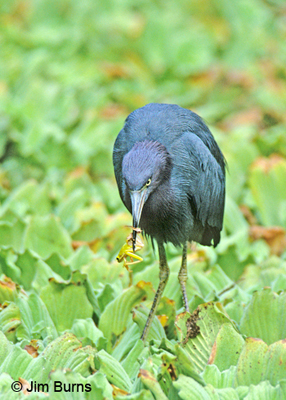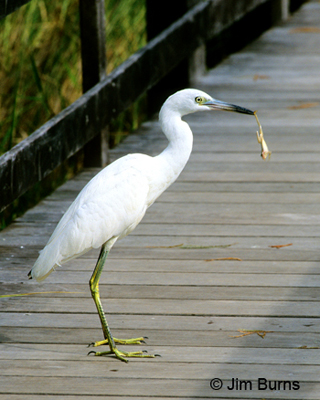|
Little Blue Heron juvenile with frog |
One of the first things birders new to the birding literature come to understand is that common names of species are always capitalized. Here's why. Let's say you went for a walk along the Scottsdale Greenbelt and saw a small heron that appeared to be slate blue in color. If you came home and posted it to the bird hotline on the web as a "little blue heron," any knowledgeable birder reading your post would yawn and wonder why you bothered. If, however, you posted it as a "Little Blue Heron," all caps, birders from all over the state would be scrambling to get to Scottsdale and congratulating you for your perspicacious discovery.
There are six North American heron species which might appear slate blue to a casual observer depending upon the intensity of light and the bird's age. These six range in size from the huge, pterodactyl-like Great Blue Heron down to the small Green Heron which is about one-third the Great Blue's size and shows no hint of green unless it is in direct sunlight. Another of the six is the Little Blue Heron, a water bird of the Southeast and lower Baja, which shows up somewhere in Arizona less than annually. Complicating matters, immature Little Blues are white before they molt into their slate blue adult plumage.
So . . . did you see a small heron that looked blue to you, or did you see a Little Blue Heron? Did you see one of the large, noisy, long-tailed black birds so common in the Valley, a Great-Tailed Grackle, or did you actually find a Common Grackle, an Eastern species very rare to Arizona? Or perhaps a friend emails about a crested, red bird in her yard--no not a Northern Cardinal but a Vermilion Flycatcher, much less expected in an urban neighborhood.
Are you getting the picture? Think about this. If this were the last or the next column, timed to appear in the Republic's printed version, it wouldn't even have happened because without any of the capitalized species names it would have made no sense and been impossible to write. That's because the style format to which the Republic adheres does not allow common names of fauna or flora to be capitalized, and when I say "adheres" I mean like white on rice, no exceptions.
This policy has made it difficult for someone writing in the Republic, say a bird columnist, to establish credibility and properly educate non-birders. If I'm preaching to the choir, the choir is thinking I don't know what I'm doing, and if I'm seeking recruits to the wonders of the natural world, they are being misinformed. The internet is such a great educational tool because its use doesn't require seeking the lowest common denominator.
Oh, and there was a Little Blue Heron reported from Gillespie dam a couple weeks ago. The bird was ultimately correctly identified as a Reddish Egret, an even more unusual bird for our state, but without the caps in the original post no one would have bothered to check it out. Who would have guessed a newspaper's "style" could confuse rather than enlighten?
